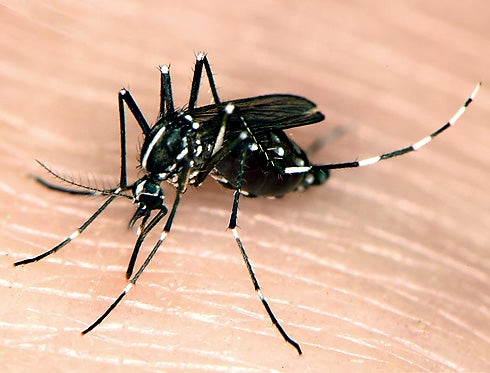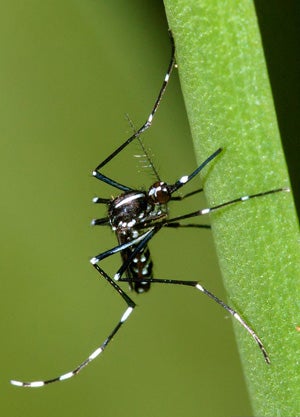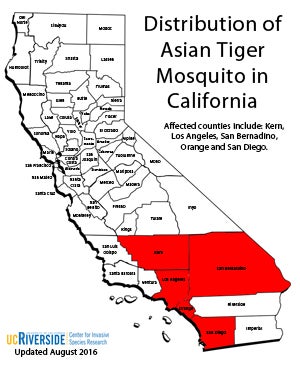Tires as Habitats for Mosquitoes a Review of Studies Within the Eastern United States
The Situation: The Asian tiger mosquito entered the United States in shipments of used tires from northern Asia in the mid-1980s. It tin survive in a broad range of climates and has spread apace from the bespeak of first detection in the south-key Us. Prior to its successful invasion of the southeastern U.Due south., isolated introductions of this mosquito were detected and eradicated in California in 1971 and 1987. In 2001, the Asian tiger mosquito was institute in 2 northern and iv southern counties of California. This mosquito did non spread to California from the ongoing invasion in eastern and central U.South., merely was introduced into the State in shipments of ornamental bamboo ("Lucky Bamboo") from Due south China. Rapid detection of introduction and control efforts prohibited the spread of this species throughout California. The tiger mosquito is a very efficient vector of a variety of mosquito-borne pathogens that cause debilitating diseases in humans and domestic animals, peculiarly horses and dogs. Description: Adults of this mosquito have black bodies with conspicuous white stripes. A distinctive unmarried white stripe runs the length of the back. Body length is approximately 0.5 centimeter. Distinct silver-white bands are axiomatic on the palpus and tarsi. Eggs are approximately 0.1 centimeter in length and dark brown to black. Eggs are laid in moist areas just above the water surface and are capable of overwintering. Eggs hatch upon alluvion and immature stages (larvae and pupae) of the life cycle occur in water. Larvae are filter feeders and occur in continuing h2o found in discarded tires, minor containers and tree holes. Pupae are comma-shaped and night brown in color. HealthRisks: The Asian tiger mosquito is an ambitious biter that feeds primarily during the 24-hour interval and has a broad host range including man, domestic and wild animals, and birds. It is a potential vector of encephalitis, dengue (all four serotypes), yellow fever and domestic dog heartworm. Westward Nile virus has been detected in this species in the eastern U.S. This mosquito is a competent vector of LaCrosse encephalitis and eastern equine encephalitis viruses. The Asian tiger musquito also is a competent vector of two encephalitis viruses routinely monitored throughout California, St. Louis encephalitis (SLE) and western equine encephalomyelitis viruses. However, recent studies propose that SLE levels in naturally infected avian hosts are more often than not insufficient to infect this musquito. Therefore, information technology might not pose equally great a threat for SLE transmission in California as doCulex mosquitoes. SLE is a viral disease which is often very serious in young children and the elderly, attacking the key nervous organization and occasionally causing expiry. Yellowish fever is an extremely serious illness that is not established in the U.Due south. or in regions adjacent to the face-to-face United States. Although the Asian tiger mosquito is a competent laboratory vector of several viral pathogens, there is no testify to date that this mosquito has acquired man disease in the U.S. Distribution:The Asian tiger musquito is native to Southeast Asia and has been spread along major transportation routes by man activities, particularly commercial motility of scrap tires, to more than 900 counties in 26 states in the continental USA as well as Hawaii.Aedes albopictuswas establish over again in California in 2001 and sporadically thereafter through 2004. Although introductions to ports and nurseries take been controlled, this species continues to pose a threat to public wellness in California. Introduction of this species in standing water, enclosed containers where pools of water are nowadays, or past desiccation-resistant eggs associated with previous pools of continuing water are likely mechanisms of invasion by this species. Research: There is no ongoing research on this species in California. Research programs carried out by the CDC and in several southeastern states are focusing on documenting the distribution of the Asian tiger mosquito, studying the competitive interactions betweenAedes albopictus and closely related species in the same genus, examining the affliction incidence in specimens collected in nature, and carrying out laboratory vector competence studies. Cooperation between federal agencies and universities has greatly aided understanding of the distribution and environmental of this mosquito. Asian Tiger Mosquito,Aedes albopictus
Source: https://cisr.ucr.edu/invasive-species/asian-tiger-mosquito



0 Response to "Tires as Habitats for Mosquitoes a Review of Studies Within the Eastern United States"
Post a Comment